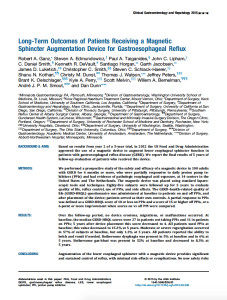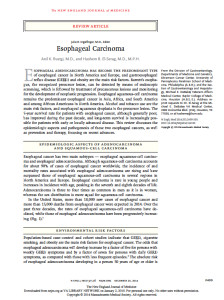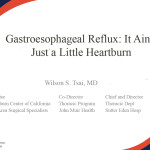Articles & Multimedia
The importance of detecting Barrett’s esophagus early
Barrett’s esophagus (BE), a term that just a few decades ago was relatively unknown or unheard of. Today, if you are one of the 20% in the United States suffering from Gastroesophageal Reflux Disease (GERD) or heartburn, then you may have heard of the term Barrett’s esophagus. What is it? Why is it important to understand it? How can you detect it and treat it? To read more, please click here.
The Importance of a Full Workup for GERD Patients
Dr. Tsai reviews the various tests that chronic heartburn or gastroesophageal reflux disease (GERD) sufferers can take to determine the root cause of their symptoms.
Long-Term Benefits of Smoking Cessation on Gastroesophageal Reflux Disease and Health Related Quality of Life
Published: February 4, 2016 | DOI: 10.1371/journal.pone.0147860 ![]()
Abstract
Objective
Smoking is associated with gastroesophageal reflux disease (GERD). Varenicline, a nicotinic receptor partial agonist, is used to aid smoking cessation. The purpose of this study was to prospectively examine the long-term benefits of smoking cessation on GERD and health-related quality of life (HR-QOL).
Methods
Patients treated with varenicline were asked to fill out a self-report questionnaire about their smoking habits, gastrointestinal symptoms, and HR-QOL before and 1 year after smoking cessation. The prevalence of GERD, frequency of symptoms, and HR-QOL scores were compared. We also investigated associations between clinical factors and newly-developed GERD.
Results
A total of 141 patients achieved smoking cessation (success group) and 50 did not (failure group) at 1 year after the treatment. The GERD improvement in the success group (43.9%) was significantly higher than that in the failure group (18.2%). The frequency of reflux symptoms significantly decreased only in the success group. There were no significant associations between newly developed GERD and clinical factors including increased body mass index and successful smoking cessation. HR-QOL significantly improved only in the success group.
Conclusions
Smoking cessation improved both GERD and HR-QOL. Smoking cessation should be recommended for GERD patients.
To read the research article, please click here
Reflux Revisited
A recently published study by scientists at Australia’s QIMR Berghofer Medical Research Institute could have a significant
impact on the study of esophageal adenocarcinoma, a rare but lethal form of cancer.Along with esophageal cancer, the study looked at two other conditions that often are overlapping or related — gastroesophageal reflux disease, known more commonly as GERD, and Barrett’s esophagus. GERD is characterized by food and stomach acid flowing back up into the food pipe. Barrett’s esophagus is a complication caused by GERD in which the tissue lining the esophagus changes to resemble the lining of the intestines. Both GERD and Barrett’s esophagus are considered key risk factors for developing esophageal cancer.
To read more, please click here
Popular Acid Reflux Drugs Are Linked To Kidney Disease Risk
People who take certain popular medicines for heartburn, indigestion and acid reflux may want to proceed more cautiously, researchers reported Monday.
The drugs, known as proton-pump inhibitors (PPIs), appear to significantly elevate the chances of developing chronic kidney disease, according to a study involving more than 250,000 people.
To read more or listen to the story, please click here
Proton pump inhibitors alter the composition of the gut microbiota
Abstract
 Objective Proton pump inhibitors (PPIs) are drugs used to suppress gastric acid production and treat GI disorders such as peptic ulcers and gastro-oesophageal reflux. They have been considered low risk, have been widely adopted, and are often over-prescribed. Recent studies have identified an increased risk of enteric and other infections with their use. Small studies have identified possible associations between PPI use and GI microbiota, but this has yet to be carried out on a large population-based cohort.
Objective Proton pump inhibitors (PPIs) are drugs used to suppress gastric acid production and treat GI disorders such as peptic ulcers and gastro-oesophageal reflux. They have been considered low risk, have been widely adopted, and are often over-prescribed. Recent studies have identified an increased risk of enteric and other infections with their use. Small studies have identified possible associations between PPI use and GI microbiota, but this has yet to be carried out on a large population-based cohort.
Design We investigated the association between PPI usage and the gut microbiome using 16S ribosomal RNA amplification from faecal samples of 1827 healthy twins, replicating results within unpublished data from an interventional study.
Results We identified a significantly lower abundance in gut commensals and lower microbial diversity in PPI users, with an associated significant increase in the abundance of oral and upper GI tract commensals. In particular, significant increases were observed in Streptococcaceae. These associations were replicated in an independent interventional study and in a paired analysis between 70 monozygotic twin pairs who were discordant for PPI use. We propose that the observed changes result from the removal of the low pH barrier between upper GI tract bacteria and the lower gut.
Conclusions Our findings describe a significant impact of PPIs on the gut microbiome and should caution over-use of PPIs, and warrant further investigation into the mechanisms and their clinical consequences.
To read the complete study, please click here
Study: Long-Term Outcomes of Patients Receiving a Magnetic Sphincter
Augmentation Device for Gastroesophageal Reflux
Abstract
Background & Aims: Based on results from year 2 of a 5-year trial, in 2012 the US Food and Drug Administration approved the use of a magnetic device to augment lower esophageal sphincter  function in patients with gastroesophageal reflux disease (GERD). We report the final results of 5 years of follow-up evaluation of patients who received this device.
function in patients with gastroesophageal reflux disease (GERD). We report the final results of 5 years of follow-up evaluation of patients who received this device.
Methods: We performed a prospective study of the safety and efficacy of a magnetic device in 100 adults with GERD for 6 months or more, who were partially responsive to daily proton pump inhibitors (PPIs) and had evidence of pathologic esophageal acid exposure, at 14 centers in the United States and The Netherlands. The magnetic device was placed using standard laparoscopic tools and techniques. Eighty-five subjects were followed up for 5 years to evaluate quality of life, reflux control, use of PPIs, and side effects. The GERD–health-related quality of life (GERD-HRQL) questionnaire was administered at baseline to patients on and off PPIs, and after placement of the device; patients served as their own controls. A partial response to PPIs was defined as a GERD-HRQL score of 10 or less on PPIs and a score of 15 or higher off PPIs, or a 6-point or more improvement when scores on vs off PPI were compared.
Results: Over the follow-up period, no device erosions, migrations, or malfunctions occurred. At baseline, the median GERD-HRQL scores were 27 in patients not taking PPIs and 11 in patients on PPIs; 5 years after device placement this score decreased to 4. All patients used PPIs at baseline; this value decreased to 15.3% at 5 years. Moderate or severe regurgitation occurred in 57% of subjects at baseline, but only 1.2% at 5 years. All patients reported the ability to belch and vomit if needed. Bothersome dysphagia was present in 5% at baseline and in 6% at 5 years. Bothersome gas-bloat was present in 52% at baseline and decreased to 8.3% at 5 years.
Conclusions: Augmentation of the lower esophageal sphincter with a magnetic device provides significant and sustained control of reflux, with minimal side effects or complications. No new safety risks emerged over a 5-year follow-up period. These findings validate the long-term safety and efficacy of the magnetic sphincter augmentation device for patients with GERD. ClinicalTrials.gov no: NCT00776997.
To read the complete study, please click here
Multi Institutional Outcomes Using Magnetic Sphincter Augmentation Versus Nissen Fundoplication for Chronic Gastroesophageal Reflux Disease.
Background: Historically, surgical intervention for gastroesophageal reflux disease (GERD) has been limited to fundoplication. Recently, magnetic sphincter augmentation (MSA) of the reflux barrier has garnered interest as an alternative surgical intervention in the treatment of GERD. Single and multicenter case series have shown safety and efficacy of MSA but comparative data to fundoplication is lacking and is required to determine the role of MSA in GERD management. We aimed to compare perioperative and clinical outcomes following MSA or Nissen fundoplication (NF). To read the complete press release for this poster presented at SAGES 2015, please click here
Nissen Fundoplication
Dr. Wislon Tsai describes and compares the normal physiology of the esophagus, chest and abdominal cavities to one that has a hiatal hernia causing GERD. He then describes one possible treatment for this type of structural or mechanical issue.
GERD Lecture
This lecture reviews Gastroesophageal Reflux Disease (GERD) / Reflux, which is often referred to as heartburn due to the sensation that reflux causes in the chest area. It provides a clear and succinct overview of the anatomy and potential reasons for the disease as well as the dangers of not addressing the root cause of the disorder.
The discussion is presented in such a way that none medical professionals should have little problem understanding the contents of the video.
Esophageal Carcinoma
Review Article from The New England Journal of Medicine
Anil K. Rustgi, M.D., and Hashem B. El‑Serag, M.D., M.P.H.
Esophageal adenocarcinoma has become the predominant type of esophageal cancer in North America and Europe, and gastroesophageal reflux disease (GERD) and obesity are the main risk factors. Barrett’s esophagus, the recognized precursor lesion, can be detected by means of endoscopic screening, which is followed by treatment of precancerous lesions and monitoring for  the development of neoplastic progression. Esophageal squamous-cell carcinoma remains the predominant esophageal cancer in Asia, Africa, and South America and among African Americans in North America. Alcohol and tobacco use are the main risk factors, and esophageal squamous dysplasia is the precursor lesion. The 5-year survival rate for patients with esophageal cancer, although generally poor, has improved during the past decade, and long-term survival is increasingly possible for patients with early or locally advanced disease. This review discusses the epidemiologic aspects and pathogenesis of these two esophageal cancers, as well as prevention and therapy, focusing on recent advances.
the development of neoplastic progression. Esophageal squamous-cell carcinoma remains the predominant esophageal cancer in Asia, Africa, and South America and among African Americans in North America. Alcohol and tobacco use are the main risk factors, and esophageal squamous dysplasia is the precursor lesion. The 5-year survival rate for patients with esophageal cancer, although generally poor, has improved during the past decade, and long-term survival is increasingly possible for patients with early or locally advanced disease. This review discusses the epidemiologic aspects and pathogenesis of these two esophageal cancers, as well as prevention and therapy, focusing on recent advances.
To download the complete Review Article, please click this link: Review Article: Esophageal Carcinoma
Gastroesophageal Reflux: It Ain’t Just a Little Heartburn
Presentation by Wilson S. Tsai, M.D., which covers Gastroesophageal Reflux Disease (GERD), symptoms, research, causes, trends and treatments.
To download the presentation, please click this link: GERD Presentation


